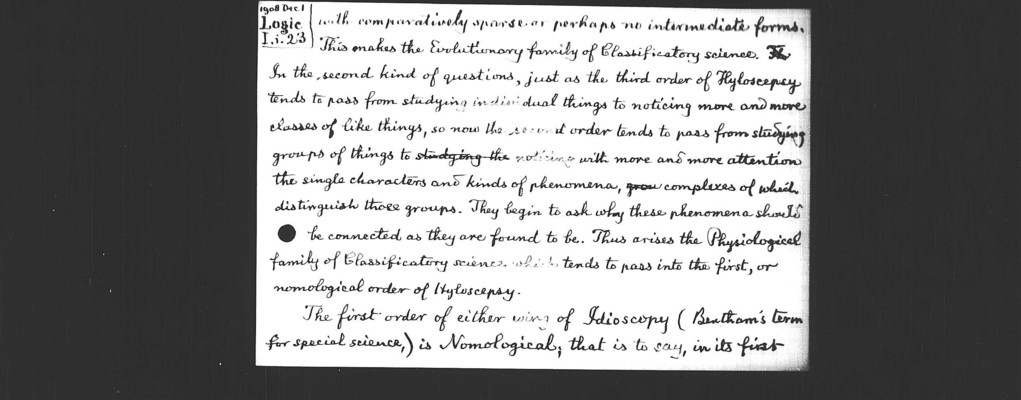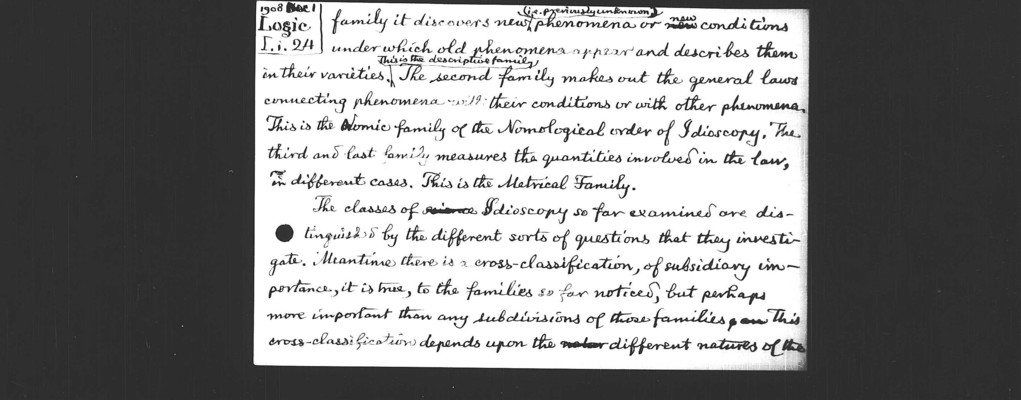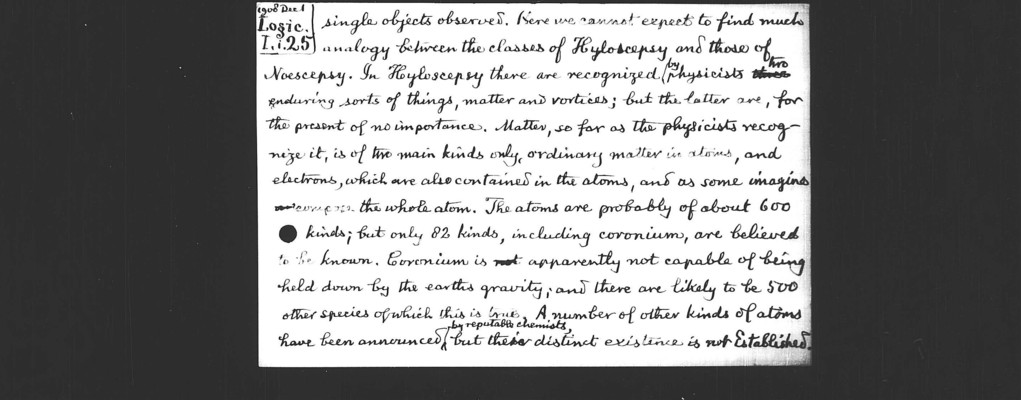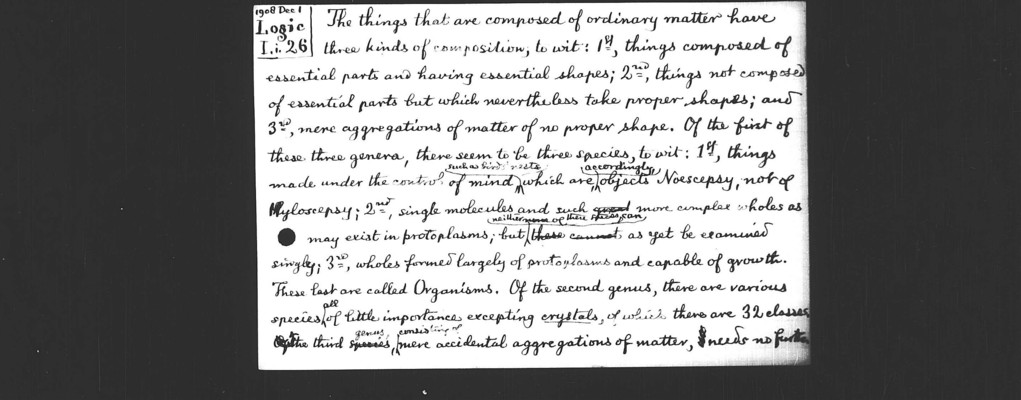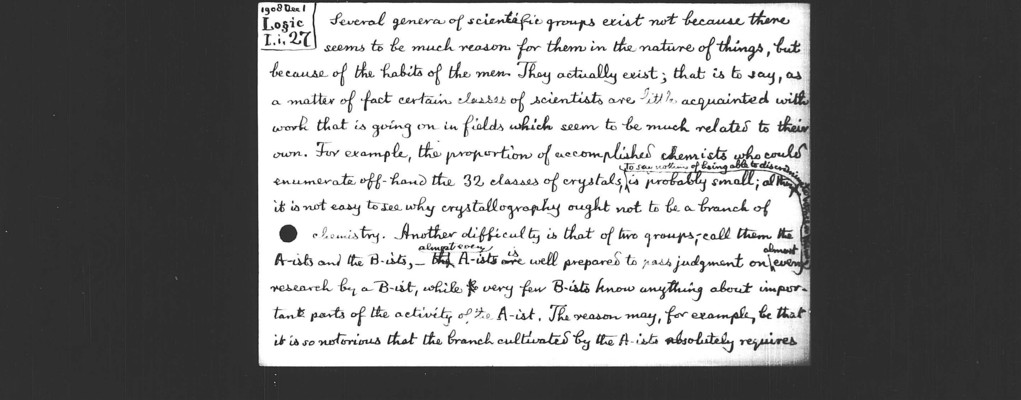Pages
120
1908 Dec 1 Logic I.i. 23
with comparatively sparse or perhaps no intermediate forms. This makes the Evolutionary family of Classificatory science. In the second kind of questions, just as the third order of Hyloscepsy tends to pass from studying individual things to noticing more and more classes of like things, so now the second order tends to pass from studying groups of things to noticing with more and more attention the single characters and kinds of phenomena, complexes of which distinguish those groups. They begin to ask why these phenomena should be connected as they are found to be. Thus arises the Physiological family of Classificatory science which tends to pass into the first, or nomological order of Hyloscepsy.
The first order of either wing of Idioscopy (Bentham's term for special science), is Nomological, that is to say, in its first
121
1908 Dec 1 Logic I.i. 24
family it discovers new (i.e. previously unknown) phenomena or new conditions under which old phenomena appear and describes them in their varieties. This is the descriptive family. The second family makes out the general laws connecting phenomena with their conditions or with other phenomena. This is the Nomic family or the Nomological order of Idioscopy. The third and last family measures the quantities involved in the law, in different cases. This is the Metrical family.
The classes of Idioscopy so far examined are distinguished by the different sorts of questions that they investigate. Meantime there is a cross-classification, of subsidiary importance, it is true, to the families so far noticed, but perhaps more important than any subdivisions of those families. This cross-classification depends upon the different natures of the
122
1908 Dec 1 Logic I.i. 25
single objects observed. Here we cannot expect to find much analogy between the classes of Hyloscepsy and those of Noescepsy. In Hyloscepsy there are recognized by physicists two enduring sorts of things, matter and vortices; but the latter are, for the present of no importance. Matter, so far as the physicists recognize it, is of two main kinds only, ordinary matter in atoms, and electrons, which are also contained in the atoms, and as some imagine compose the whole atom. The atoms are probably about 600 kinds; but only 82 kinds, including coronium, are believed to be knwon. Coronium is apparently not capable of being held down by the earth's gravity; and there are likely to be 500 other species of which this is true. A number of other kinds of atoms have been announced by reputable chemists, but their distinct existence is not established
123
1908 Dec 1 Logic I.i. 26
The things that are composed of ordinary matter have three kinds of composition, to wit: 1st, things composed of essential parts and having essential shapes; 2nd, things not composed of essential parts but which nevertheless take proper shapes; and 3rd, mere aggregations of matter of no proper shape. Of the first of these three genera, there seems to be three species, to wit: 1st, things made under the control of mind, such as birds' nests, which are, accordingly, objects [of] Noescepsy, not of Hyloscepsy; 2nd, single molecules and such more complex wholes as may exist in protoplasms; but neither of these species can as yet be examined singly; 3rd, wholes formed largely of protoplasms and capable of growth. These last are called Organisms. Of the second genus, there are various species all of little importance excepting crystals, of which there are 32 classes. The third genus, consisting of mere accidental aggregations of matter, needs no further
124
1908 Dec 1 Logic I.i. 27
Several genera of scientific groups exist not because there seems to be much reason for them in the nature of things, but because of the habits of the men. They actually exist; that is to say, as a matter of fact certain classes of scientists are little acquainted with work that is going on in fields which seem to be much related to their own. For example, the proportion of accomplished chemists who could enumerate off-hand the 32 classes of crystals, to say nothing of being able to discriminate between [??], is probably small; although it is not easy to see why crystallography ought not to be a branch of chemistry. Another difficulty is that of two groups, – call them the A-ists and the B-ists, – almost every A-ist is well prepared to pass judgment on almost every research by a B-ist, while very few B-ists know anything about important parts of the activity of the A-ist. The reason may, for example, be that it is so notorious that the branch cultivated by the A-ists absolutely requires
